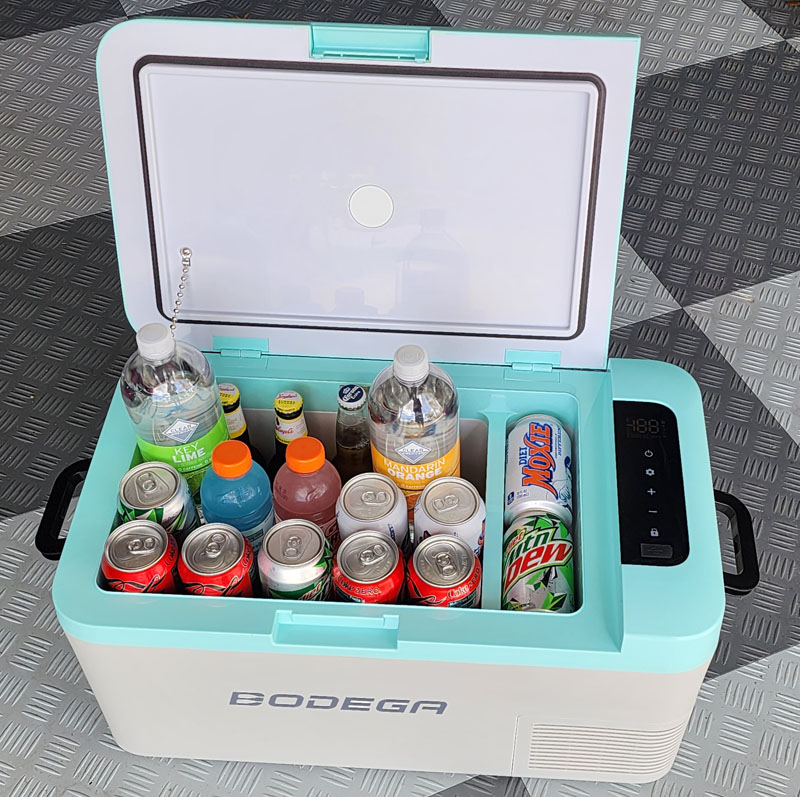
REVIEW – There’s nothing better when you’re on the road than a frosty beverage to help you pass the miles. Keeping those beverages frosty is the challenge. It usually involves copious amounts of ice that take up additional beverage space in the cooler. In the end, it winds up as a soggy mess that must be dumped without soaking your vehicle interior. BODEGAcooler (Bodega for short) is a maker of a slew of small refrigerators and freezers that covers a wide variety of use cases. Today, we’re going to look at the K18 Bule 20-quart portable car fridge/freezer. The K18 designation comes from its capacity of 18 liters (20 quarts).
What is it?
The BODEGA K18 Bule is a dual-zone refrigerator/freezer capable of holding 19 quarts of goodies in the main compartment and 1.3 quarts in the small second compartment. It is designed to be portable and be powered by either wall socket power or from a 12V automotive cigarette lighter style power source. With a refrigeration range of -4ºF~68ºF, it can serve as a portable refrigerator or freezer, but not both simultaneously.
What’s in the box?
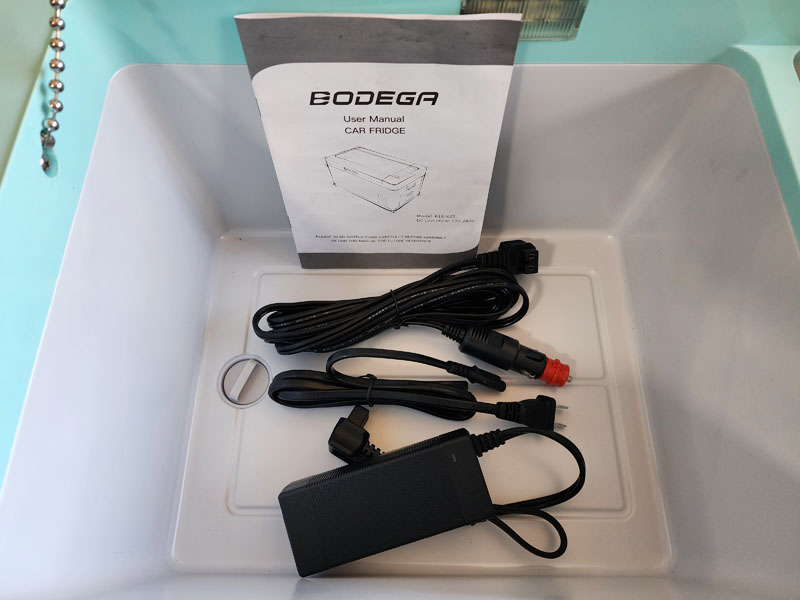
- BODEGA K18 Bule 20 Quart Portable Car Fridge/Freezer
- 12V/24V DC power cord (11 feet)
- 100V-240V AC power cord with adapter (7 feet total length with adapter)
- User manual
Hardware specs
- Dimensions: 24 x 13 x 12 inches
- Fridge capacity: 20 quarts
- Left zone / Right zone: 19 quarts (13.125″ w x 10.25″ d x 8.625″ h)/ 1.3 quarts (2.75″ w x 10.25″ d x 3″ h)
- Item weight: 26.6 pounds
- Refrigeration range: -4ºF~68ºF
- Noise level: <42dB
- Operation: 100-240V / 12V / 24V
- Rated input power: 60W
- Rated current: AC 1.5A-2.7A , DC 6.0A(12V) / 3.0A (24V)
- App control: Bluetooth via Android or iOS app
- Additional output: USB
Design and features
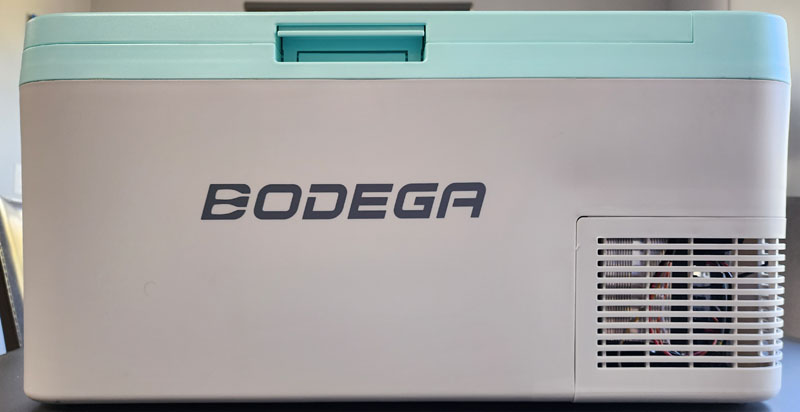
The BODEGA K18 Bule 20 Quart Portable Car Fridge/Freezer is styled like a typical cooler with a hinged top lid and fold-out handles on the side. The photo above shows the front of the K18. You can see some of the cooling system ventilation slots on the lower right.
The left side holds one of the fold-out carry handles.
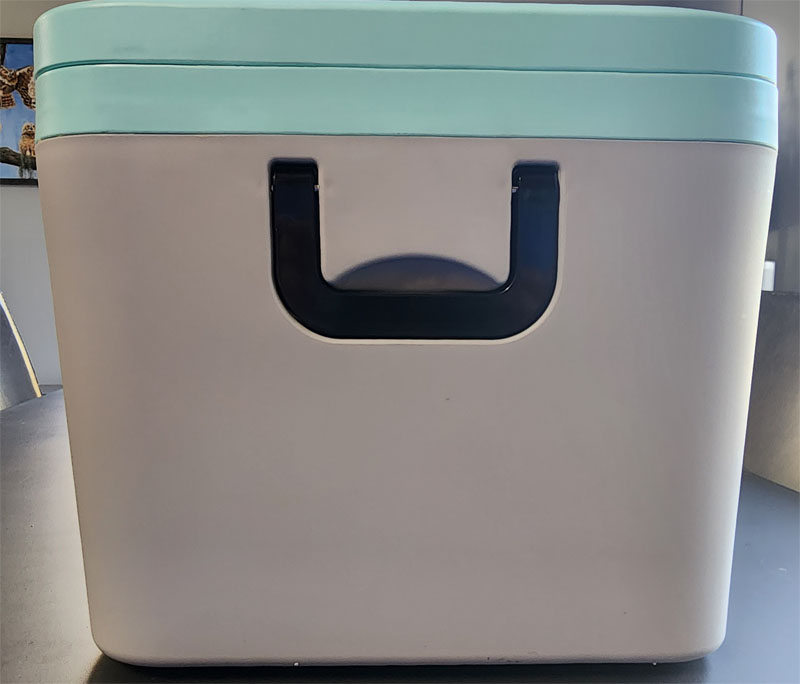
On the back, we can see the top hinges and more of the vent.
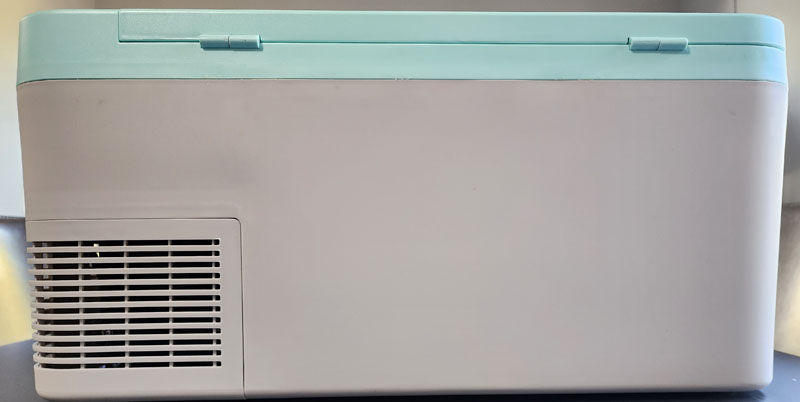
On the right side, we see the second handle, the rest of the vent, and the socket for the power cords.
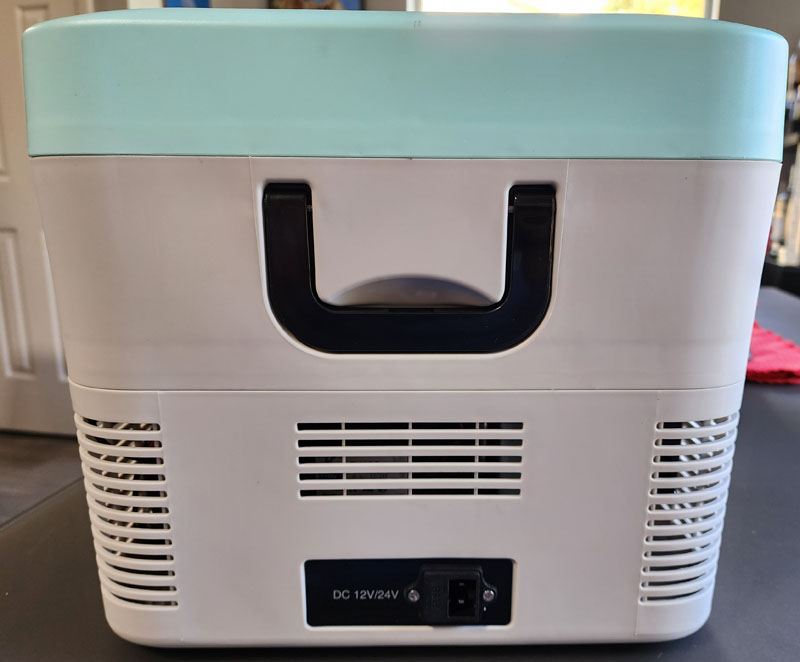
That power socket accepts both the 110V/240V cord and the 12V/24V cord.
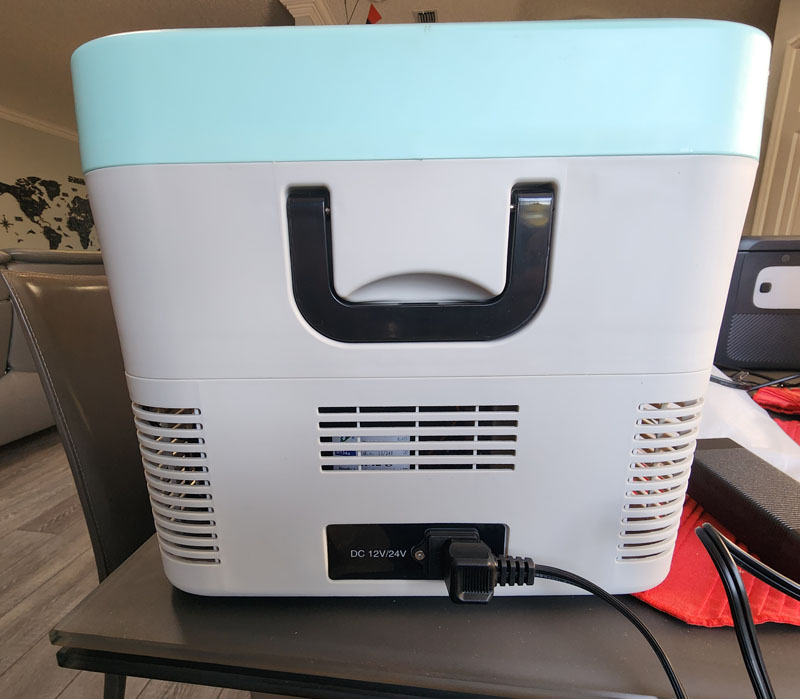
Underneath, we see the four rubber feet at the corner, the drain outlet on the right, and the usual technical label.
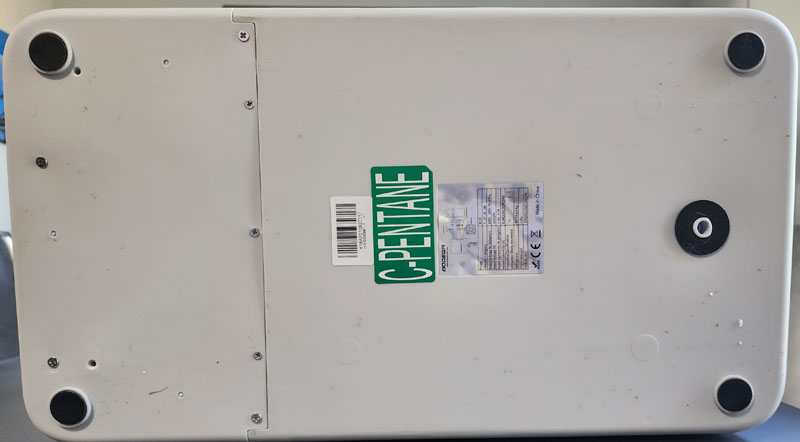
To open the BODEGA K18 Bule 20 Quart Portable Car Fridge/Freezer, squeeze the handle in the center of the lid.
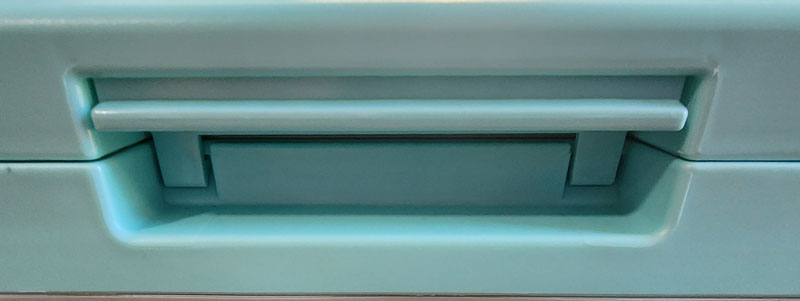
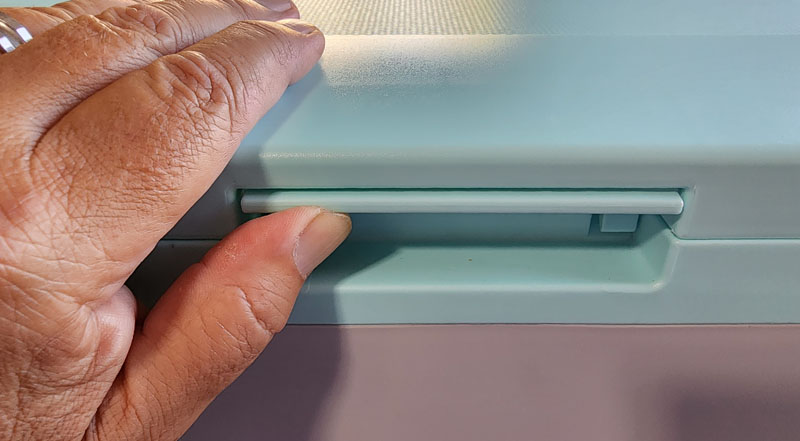
Inside, we see the 19-quart main compartment (13.125″ w x 10.25″ d x 8.625″ h) and the small 1.3-quart second compartment (2.75″ w x 10.25″ d x 3″ h) on the right. I don’t understand the point of the two zones. They are not independently controlled. The small one can just hold two cans or perhaps a skinny bottle like a 16-ounce water bottle or a long-neck beer.
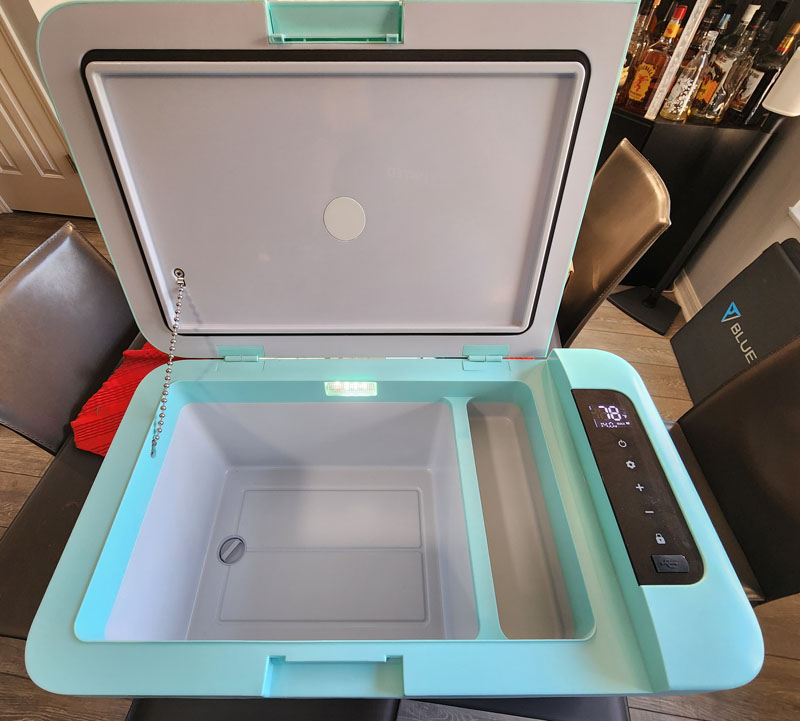
Do you see the vents in the main compartment? No? That’s because there aren’t any. There is no air circulation in the cooling chamber. This is important as we will see in the performance section below.
We can also see the top-mounted control panel on the right side of the lid. The drain plug is on the bottom left side of the main compartment.
In the center top rim of the main compartment, you can see the LED that illuminates the compartment.
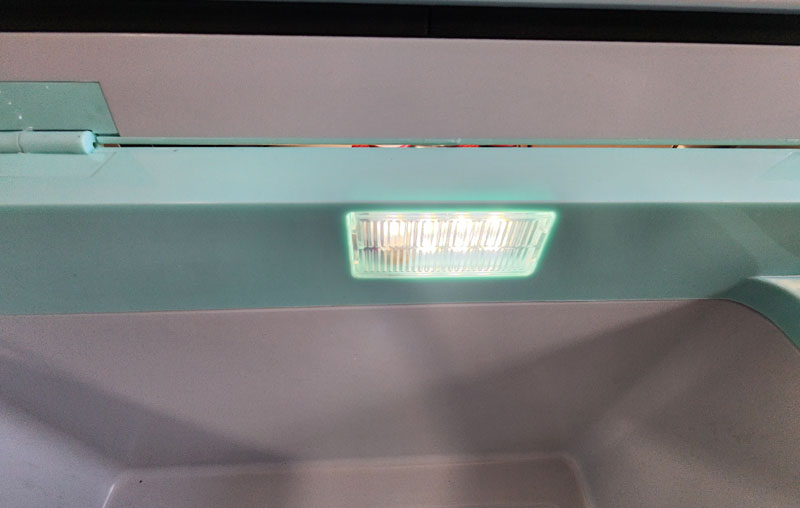
The lid is kept from flopping over by a sturdy ball chain on the left side.
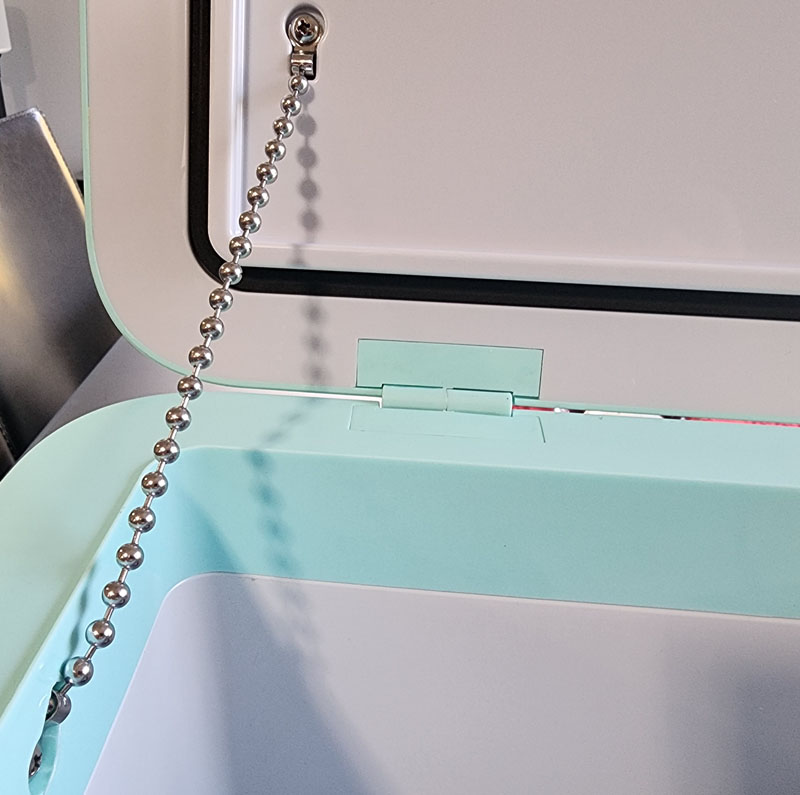
The lid is rimmed with a rubber seal.
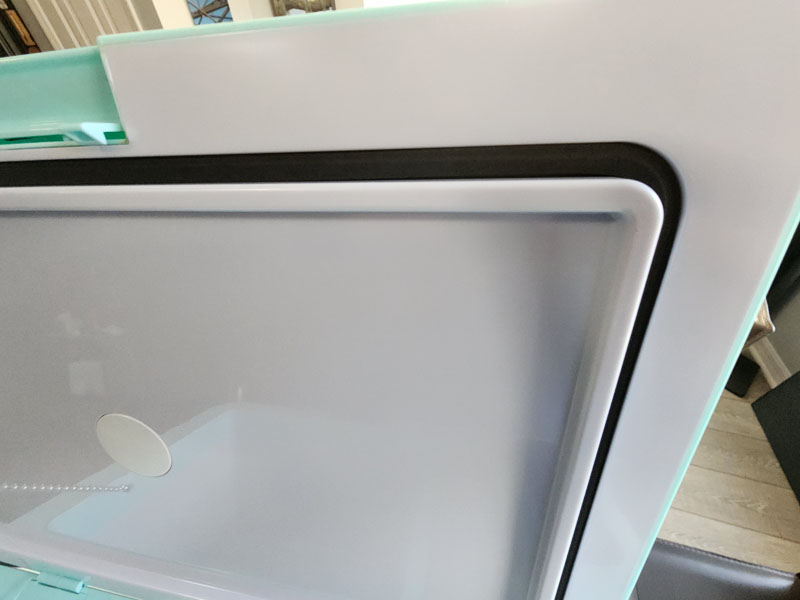
The control panel is located on the right side of the top of the BODEGA K18 Bule 20 Quart Portable Car Fridge/Freezer.
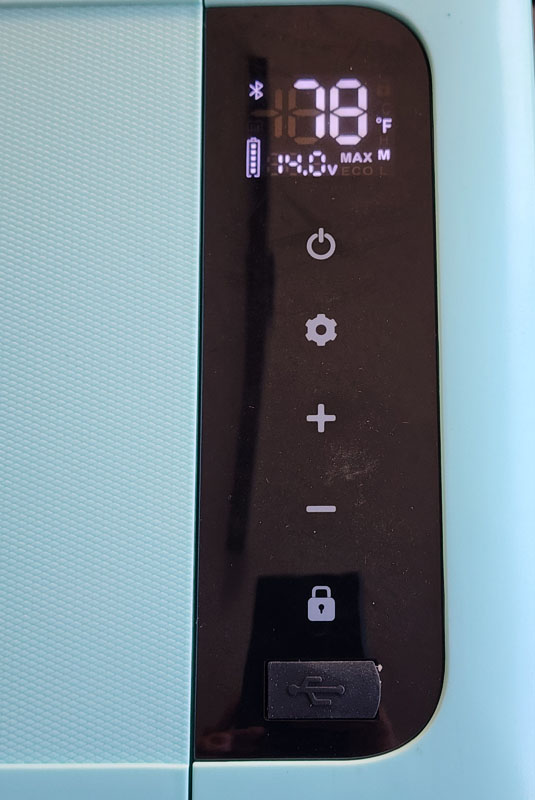
The power, settings, up(+), down(-), and lock buttons let you control everything. The display defaults to showing you the temperature in the main chamber. Pressing +/- lets you change the set point.
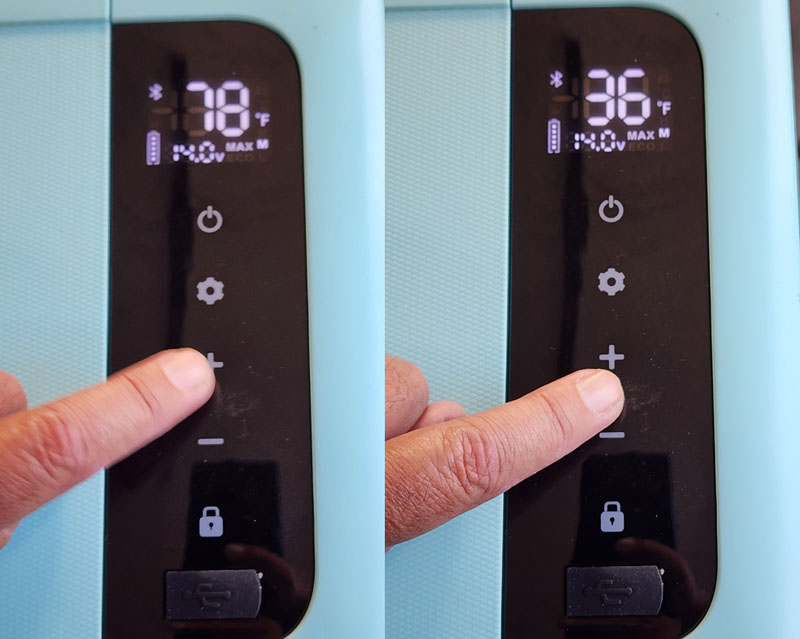
The display shows you a battery icon indicating input voltage. It seems like the display is designed for units with an internal battery. Sadly, this unit does not have one. You can also see the Bluetooth icon indicating that the K18 is connected to an app device. The display also shows Max/Eco cooling modes and L-M-H battery protection to prevent battery rundown when it is plugged into your car. These modes are selected using various press combinations with the settings button. Holding the lock button locks out the rest of the buttons, preventing accidental changes.
Just below the lock button, we see a USB-A port that can be used to charge your portable devices as long as the BODEGA K18 Bule 20 Quart Portable Car Fridge/Freezer is plugged into power.

Setup
The setup is simple. Plug in the K18 and set your desired temperature. You can set it for max cooling or eco cooling. Max is faster and uses more power. That’s only an issue when running off an external battery. If it is plugged into the wall or a running vehicle, the power draw shouldn’t matter. When plugged into a car, you certainly don’t want to kill your car’s battery. There’s where battery protection comes in. When set to (H)igh, the unit will shut off before killing your battery completely. You can also set it to (M)edium or (L)ow protection. The manual doesn’t explain exactly what will happen, but it doesn’t recommend it when using your car’s battery.
What if you don’t like fiddling with the control panel, or perhaps you can’t, like when riding as a passenger in a car and the cooler is plugged in in the back? There’s an app for that! Available for iOS and Android, the Car Fridge Freezer app lets you control all aspects of the K18 right from your phone.
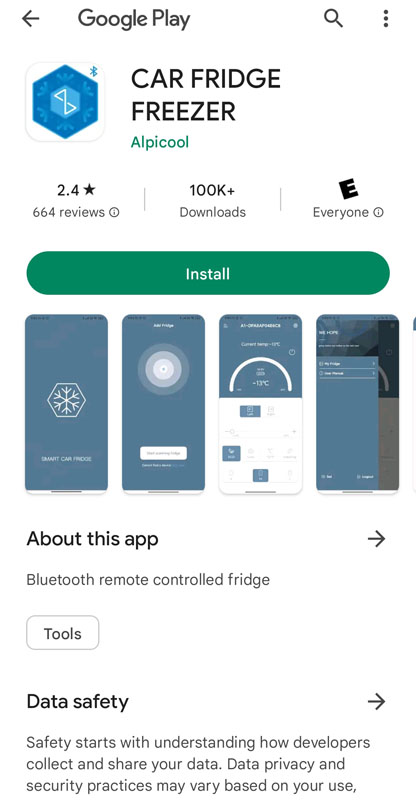
It connects via Bluetooth. When you pair, the app searches for the fridge.
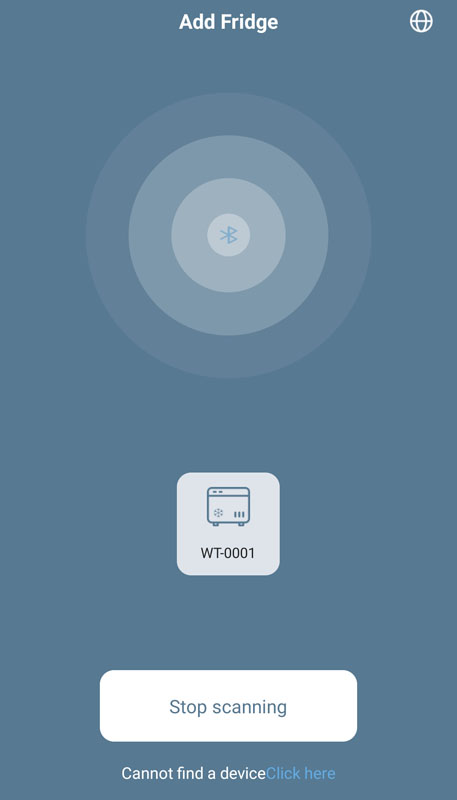
When it finds the fridge, it displays it in the app. You click on it and it connects to the refrigerator. The BODEGA K18 Bule 20 Quart Portable Car Fridge/Freezer shows “AP” on its display and the app prompts you to hit the settings button on the control panel to complete the connection.
Once paired, you have access to all the settings and the manual.
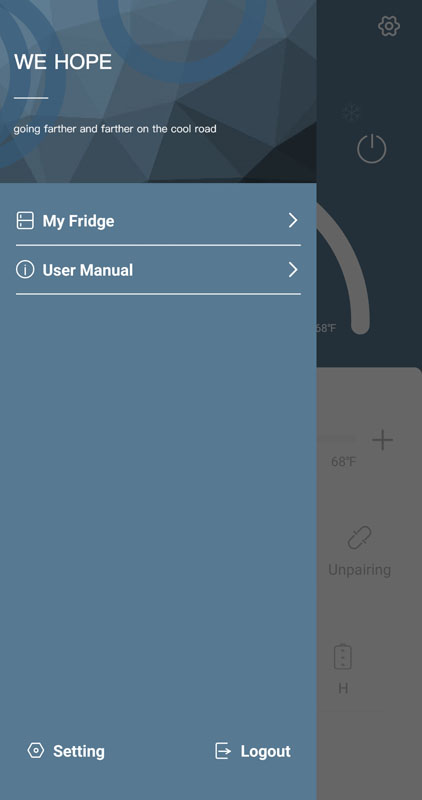
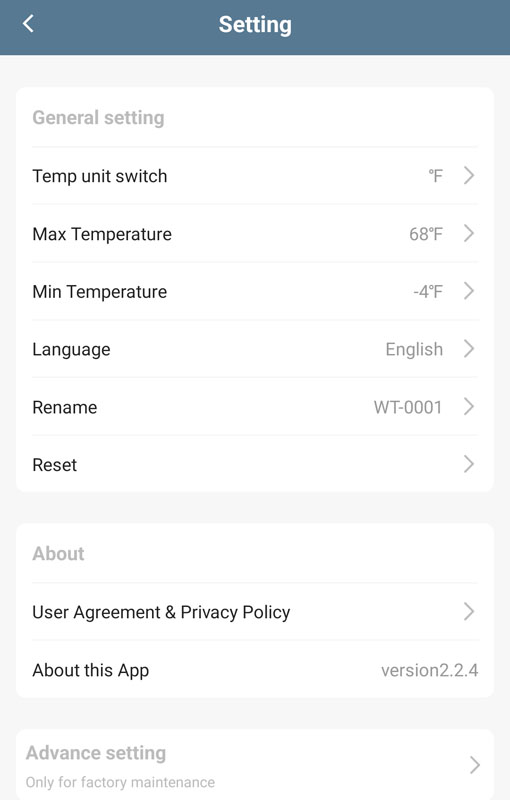
The app seems to work well and all changes I made either in the app or via the control panel were immediately shown in both the app and on the control panel.
Performance
Let’s take another look at that lead image.

I patterned this after many of the images on Bodega’s website. Notice anything wrong with this photo? Here’s a hint: try closing the lid! I have never understood advertising photos like this but all the companies do it. Oh well, let’s look at a more practical loading method.
I started with cans of pop. For all my non-midwest readers, “pop” means “soda”. Even though I live in Florida now, my Michigan roots show up from time to time.
12-ounce cans fit neatly in two rows of five cans. This photo shows two layers of cans. Another layer fit easily. With two more cans in the right compartment, that totals 32 cans of chilled goodness.
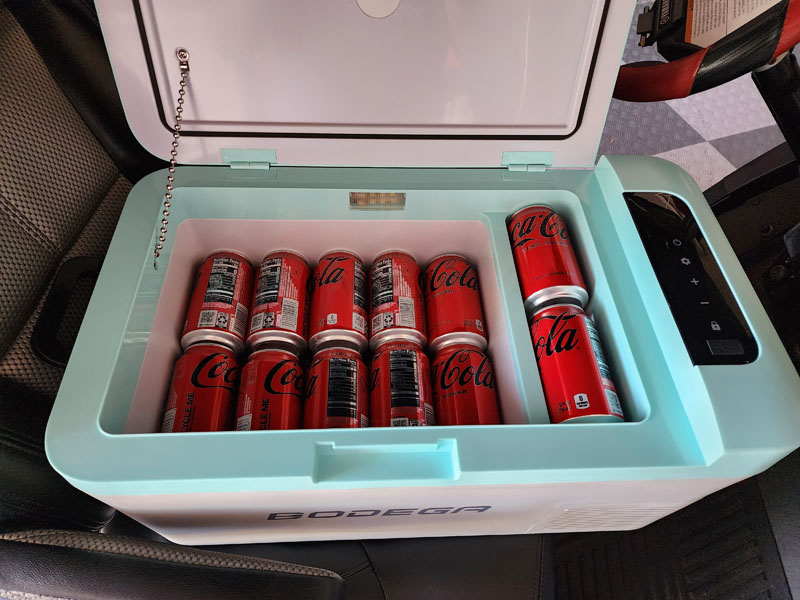
Next up were 2-liter bottles. I was able to fit two per layer for a total of four.
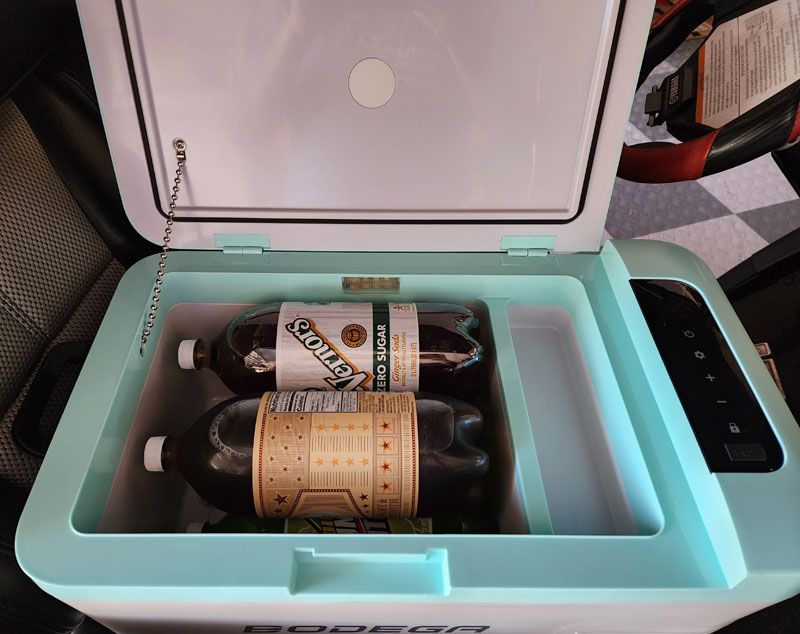
Six long-neck beer bottles would fit per layer with three layers able to fit for up to an 18-bottle capacity.
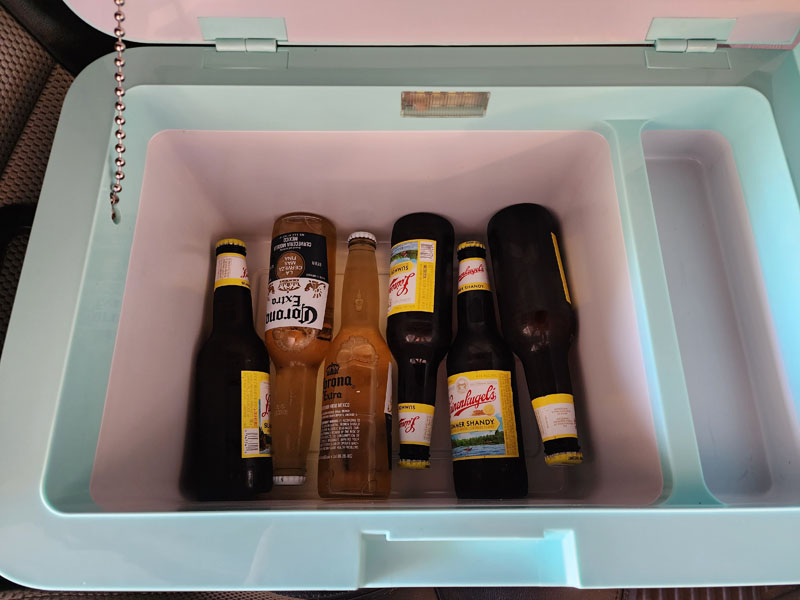
Wine bottles were a little more nebulous since wine bottles vary greatly in design. I’d guess that you should be able to fit six to eight bottles, depending on the bottle styles.
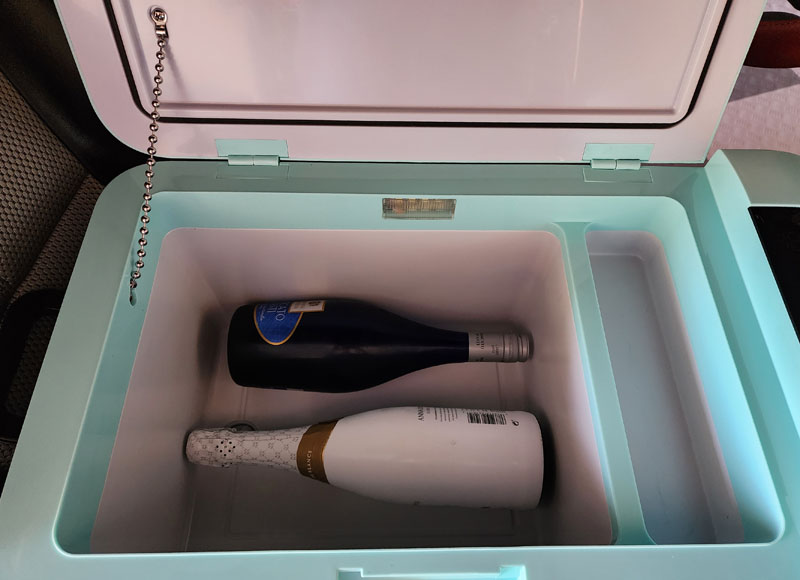
Finally, I grabbed some one-liter bottles of flavored water. I could fit eight bottles in two layers of four bottles.
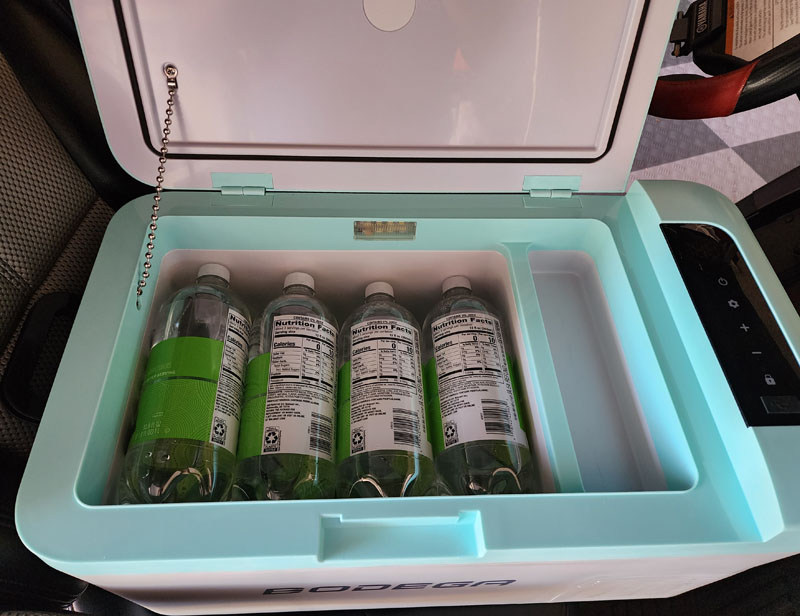
One thing to note here is that 100% of the space is being used by contents and none by ice. That’s the differentiator between a solution like the K18 and a regular cooler. With the BODEGA K18 Bule 20 Quart Portable Car Fridge/Freezer, you don’t lose space to ice.
After all this packing and unpacking, I brought the cooler inside and plugged it in. The control panel reported the temperature as 78 degrees. I set the K18 for a brisk 36 degrees and let it get to cooling. I was surprised by how quiet the K18 was when the compressor was running. Bodega claims that the sound should be less than 42 decibels and I certainly can’t argue with that. It is quiet. For reference, soft library sounds are about 40 decibels, so the K18 should be quieter that the librarian’s “Shhhhhh“. In less than 20 minutes, the K18 had dropped its internal temperature by 42 degrees and the K18 was happily maintaining 36 degrees. I had the K18 plugged into a monitoring power source and it reported that the K18 was drawing 61 watts when running. That dropped to less than a watt when the compressor was off. Of course, if you pack the K18 with room-temperature goods, it will take considerably longer to get down to temp since it will be cooling everything inside the compartment as well.
To test the K18’s insulation, I placed a refrigerator thermometer inside and let it settle again at 36 degrees. Then, I turned it off and let it sit, undisturbed for an hour. At the end of the hour, the thermometer showed 52 degrees or a 16-degree rise. That seemed excessive, suggesting that the insulation around the cooling chamber could be more effective. Of course, if you had the compartment filled with cold items and turned off the unit, it would certainly maintain the temperature much better.
For us, I think the sweet spot for using the BODEGA K18 Bule 20 Quart Portable Car Fridge/Freezer will be making trips to the store. Here in central Florida, we are well above 90 degrees typically from mid-April until mid-November. That makes trips to the store a challenge when we’re buying fresh or frozen meat, ice cream, chocolate, or other chilled or easily melted grocery items. We use freezer bags, but a freezer bag in the back of a 120-degree SUV is also 120 degrees when you load the food.
The back of my SUV has a 120V socket. The issue is that it is only powered when the vehicle is running. This means the K18 will only be actively cooling on the drive down and then back. If we need to make a stop on the way home, the K18 will not be cooling our food. The two cigarette lighter sockets in our vehicle are powered all the time, but they are both up in the front seat area so we would have to run the power cable all the way back in the vehicle – a bit of a sloppy solution.
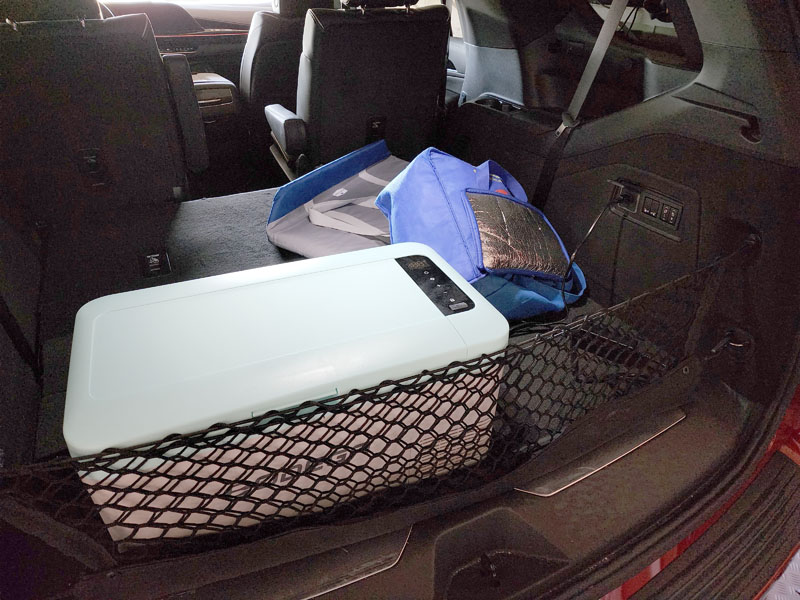
Another, and perhaps a better option is to use a portable power station. I have one that can power the K18 for several hours. That way, when we bring out the cold food, we can drop it into a running and cold refrigerator immediately. It is too bad that the K18 doesn’t have a built-in battery that could run the K18 for 3-4 hours. That would make this much more usable. Of course, I’m sure that would increase the price.
I decided to give it an inaugural run, but instead of the SUV, I used the golf cart. Here is the K18 in the back of my cart.
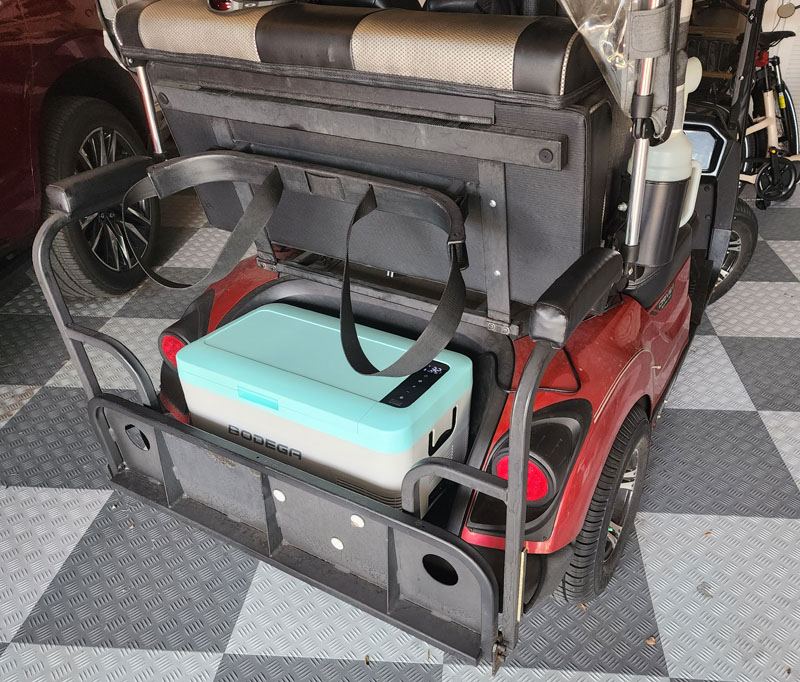
To power the K18, I strapped the BLUETTI AC60 portable power station into the passenger seat and plugged in the K18.

Today was a pretty typical central Florida day with the feels-like temp into the 90s.
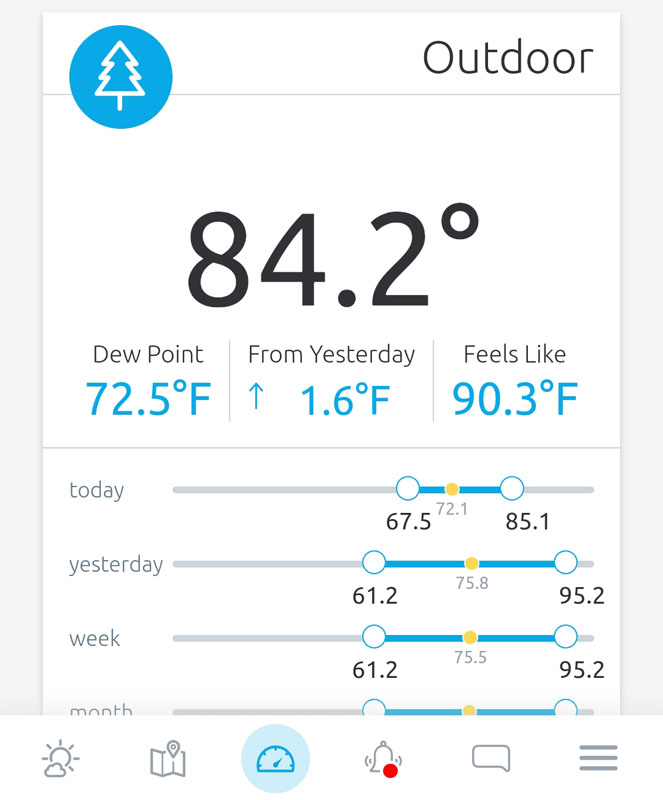
I drove the 9.5 miles from home to our local BJ’s warehouse club store. The K18 dropped the temperature from 74 degrees (the K18 was in the house before I left) to 34 degrees. It was set for 32 degrees but would warm up a couple of degrees between cooling cycles.
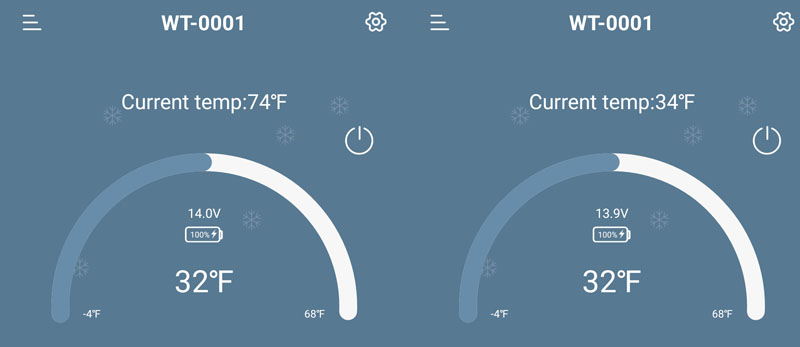
I loaded up the cooler with a box of toaster waffles and four pounds of butter. That pretty much filled the K18’s 19-quart capacity.
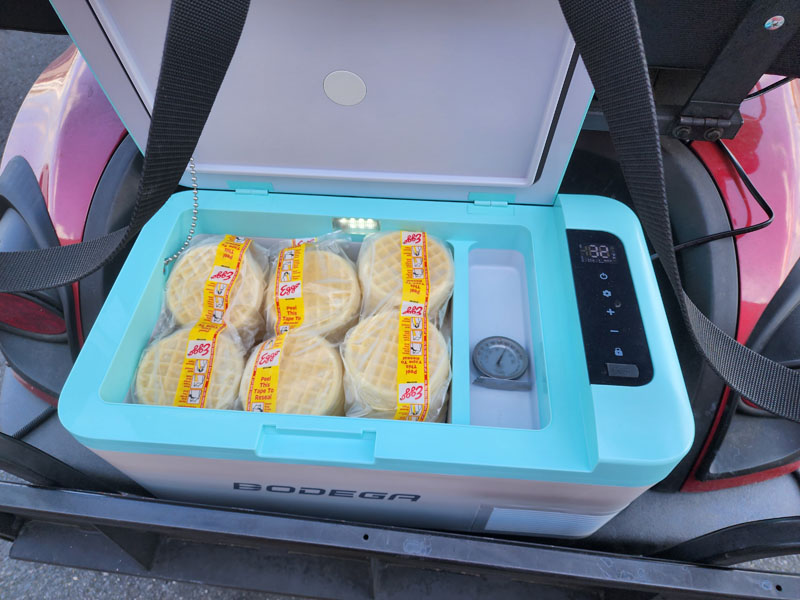
After a 9.5-mile return trip, everything was chilled nicely.
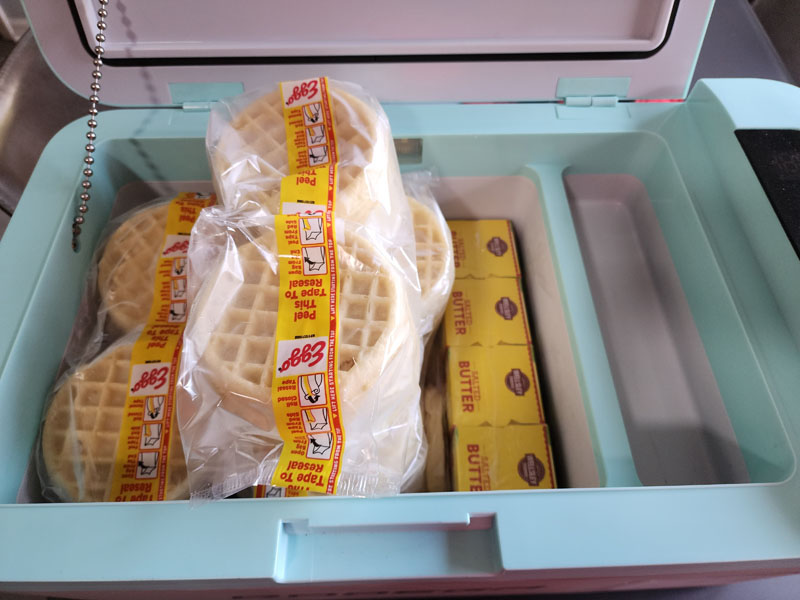
This confirmed for me that this specific cooler’s capacity is a little too small for grocery use. Our freezer bags won’t be leaving the SUV anytime soon. A half gallon of ice cream, a dozen eggs, and a gallon of milk would leave little room for anything else. But, 32 cans of your favorite beverage is plenty for a day at the beach. How well this cooler works for you depends on your use case.
One thing I noted was that the small 1.3-quart cooler section didn’t feel cool. Once I emptied the cooler, I placed a standard refrigerator thermometer in the main section and let it sit for a while. The BODEGA K18 Bule 20 Quart Portable Car Fridge/Freezer reported 34 degrees and the thermometer agreed with it. Then, I placed the thermometer in the small section, closed the lid, and waited for a while longer. when I opened the lid, I was surprised to see the thermometer report that the temperature was 50 degrees! I wondered if it was perhaps because I opened the cooler too much during the test. I closed it up and let it set for 90 minutes. When I opened the lid, the thermometer read 50F and the cooler reported 29F. Wow.
This got me wondering about how the fridge cooled. Feeling around in the cooler, the floor felt cool as did the walls. The walls picked up a thin layer of ice from the humid Florida air that I let in when the lid was open. So, the cooling is delivered from the bottom and the sides. The second compartment is at the top, above the cooling area. As we all know, heat rises, so very little of the cooling reaches the small compartment, hence the 50-degree temperature reading. If there was some sort of air circulation system to move the cold air throughout the cooling chamber, performance would be greatly improved.
For another test, I placed a can upright in the cooler and then placed the thermometer on top of it. This put the thermometer near the top of the main compartment. I waited for a while and checked the thermometer. It read 36F. Not 34F, but close enough. Even with only radiant cooling, the main compartment seemed to be close to uniform from top to bottom. During this test, I kept checking the app. With the temperature set to 34F, I watched the reported temperature vary from 27F to 41F. That seemed like a pretty big swing to me. With the temp set to 34F, once the reported temperature hit 38F, the compressor would turn on. The temperature would continue to rise for a moment and then begin to fall. Once the temperature hit 34F, the compressor would turn off but the reported temperature would continue to fall to 27F and then start rising again.
Of course, this was all with a mostly empty refrigerator – not exactly a real-world test. So, to be a little more realistic, I loaded it up with eight 1-liter bottles of water and let it sit overnight. Once the contents are chilled, the contents themselves should help regulate the internal temperature.
The next day, I watched a cooling cycle and it did seem to balance out better, rising to 39F and then cooling to 32F, a +5/-2 degree swing versus the +7/-7 degree swing when empty. I pulled out a bottom from the top row and another from the bottom row and checked the temperature.
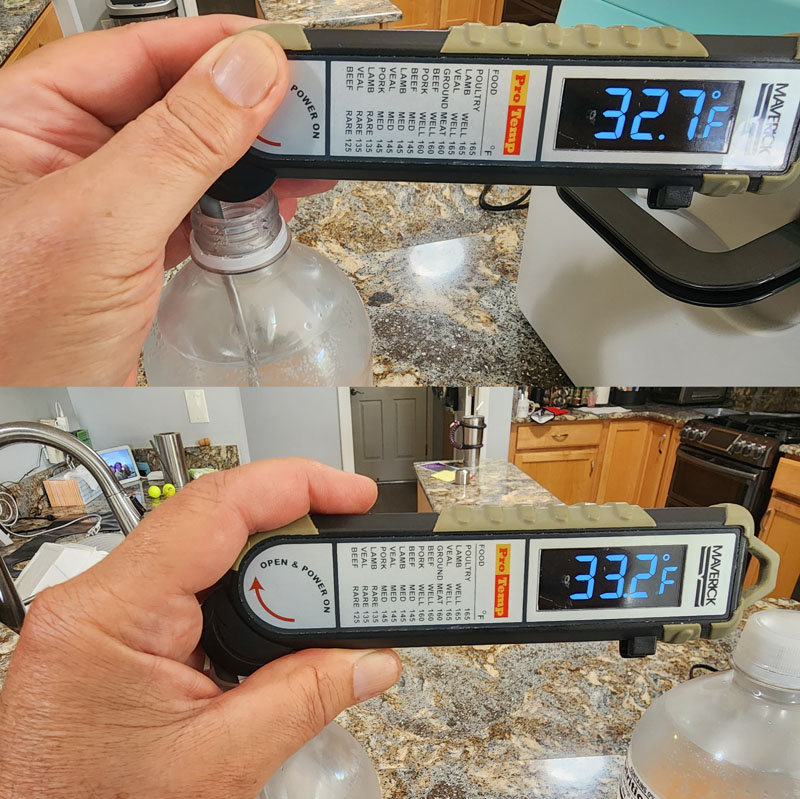
Much to my surprise, the top bottle was a half-degree cooler than the bottom bottle. So, my assumption that a full load would balance the internal temperature proved to be true. Even after running for about 22 hours, the 1.3-quart small compartment still felt barely cooler than room temperature. I really don’t understand what that is intended to be used for.
What I like
- Clean design
- Quiet operation
- Cools quickly
- Nice cooling temperature range from deep freeze to just below average room temperature
- You don’t lose content space to ice
What I’d change
- An internal battery would be a great addition
- The small 1.3Q section seems to be essentially useless and doesn’t cool well – I would eliminate the small compartment, or perhaps explain the thinking behind it
- A fan to circulate the air in the main compartment seems like it would improve cooling performance
- A longer AC power cord would be nice – perhaps 10 to 12 feet rather than the short seven feet
- It could be insulated better
- This model is a little small for groceries
Final thoughts
Generally, I like the BODEGA K18 Bule 20 Quart Portable Car Fridge/Freezer. It seems to be well-made, the app works well, and it cools well. I wish it was bigger. I wish it circulated the air in the cooling chamber. Still, it does chill its contents enough to make them enjoyable. BODEGAcooler offers models with capacities from 20 quarts to 85 quarts, and of course, the larger models are more expensive. If you’re looking for a powered cooler, it’s worth taking a look at BODEGAcoolers’ line as they probably have one that will meet your needs. I do know that on our next road trip, we will be well-hydrated with nicely chilled beverages.
Price: $289.99 (on sale for $231.99 as of this writing)
Where to buy: BODEGAcooler and Walmart
Source: The sample of this product was provided by BODEGAcooler.


